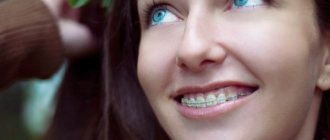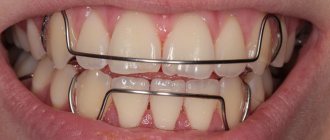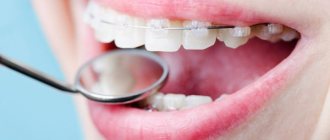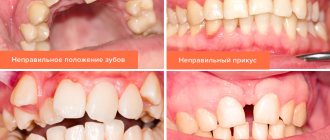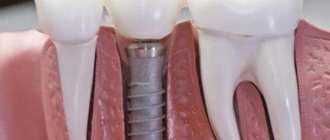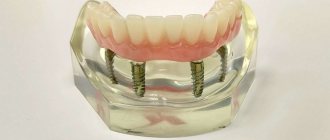The time when orthodontic treatment was considered childish is irrevocably gone. The number of adult patients who seek help from orthodontists is growing every day, and no one is surprised that a person gets braces at 20 years of age or older.
On a note!
For Russia, orthodontics is still a very young science, no more than 30 years old, while in the USA it has almost a century-old history, and braces have become commonplace there. This is one of the main reasons that most Russian patients are already adults. They simply did not have time, and by and large could not, undergo treatment in childhood.
Is it worth getting braces at 20–30 years old?
Many are still convinced that it makes no sense for an adult to wear braces, that it is time-consuming and expensive, and there is no guarantee of success. However, the increase in the number of patients in the orthodontist's office is the best evidence to the contrary.
Dentists identify several reasons for the increase in demand, but the main one is the understanding that there are no age restrictions! Significant factors that significantly increase interest in brace systems are:
- enlightenment – people become more literate thanks to the abundance of information, including in the field of medicine and health;
- treatment prospects – orthodontics is developing very dynamically, and practicing doctors have more and more new devices and methods at their disposal that solve even the most complex problems;
- the desire to preserve your own teeth for as long as possible;
- integrity of perception - most people understand how close the relationship is between bite, appearance and health.
If there are indications, an adult should get braces, and it doesn’t matter how old he is. But only under one condition - he himself must want it, since the treatment process is slow and can cause some inconvenience.
On a note!
Almost half of patients do not even realize that there is something wrong with their bite. And the consequences that arise years later are attributed to other reasons.
When are the first results visible?
Wearing braces, as is clear from everything written above, is a very lengthy process. However, some results can be seen after just a month. After three months, as a rule, the bite is almost perfectly aligned, and all the teeth are in their places. The rest of the time is needed for the teeth to finally fall into place and secure themselves in position.
True, in some situations it happens that months drag on, and the bite visually does not change in any way. In this case, experts advise not to be alarmed, because each organism is individual, and some may need more time. Remember that there is absolutely no point in stopping wearing braces due to lack of results - just wait a little, and soon your expectations will be met.
During the first two weeks of wearing braces, a person’s oral cavity adapts to the presence of braces in it and to the beginning of the process of correcting the bite. The procedure is very difficult and is characterized by the occurrence of various negative sensations in the oral cavity. This could be, for example, continuous severe pain in the teeth, redness or inflammation of the gums, chafing on the inside of the cheeks and, possibly, lips. Almost all braces wearers think that results will come instantly, within a few weeks of leaving the doctor's office.
We suggest that you familiarize yourself with Short frenulum of the tongue in a child or newborn. How to determine the signs at what age to prune
But this system does not have magical powers, it only helps to cure a certain dental pathology, and the main healing process occurs through the natural growth and development of teeth. From this we can conclude: you should not expect a quick bite correction. The treatment period can last for months, or even years.
Which braces to choose
The best option for adults is ceramic systems, since metal ones do not look very solid. But ceramics look very aesthetically pleasing even in photographs, since they do not glare in the light. Although this is just a subjective opinion, and some patients prefer the noble metal.
Non-ligature systems are more effective and less noticeable on teeth. They act faster, but are somewhat more expensive.
If you want to keep the treatment secret from others, you can order lingual braces. They are the most low-profile, that is, they extend to a minimum distance from the surface of the teeth, so there are no problems with speech. Lingual systems are made individually and do not have sharp corners that injure the oral mucosa.
Adults are advised to choose braces with additional enamel protection to prevent the development of caries.
In some cases, with serious deviations in the dentofacial apparatus, only metal systems can help. They are also given preference when there is a lack of financial resources.
Are braces the last stage of orthodontic treatment?
After removing braces, you need to consolidate the effect of straightening your teeth. For this purpose, retainers are made that will protect teeth from returning to their original place.
There are two types of retainers:
- Removable – transparent, plastic mouth guards. Used only at night or during a certain period.
- Non-removable - made of metal. They are installed on the back surface of the teeth using special composite materials.
The decision on the best method is made by the orthodontist. The aligners must be worn at all times during the first month, removed only for eating and brushing your teeth. On average they are worn for 2 years.
While wearing retention devices, you must visit a doctor every 3-6 months.
How long to wear braces
Metal systems provide the shortest treatment duration. But no orthodontist can give an exact date, since it depends on many factors:
- type of defect;
- oral health conditions;
- individual characteristics;
- age.
On a note!
You will have to wear ceramic and sapphire braces for the longest time.
The permanent dentition does not develop until approximately 25 years of age, when the eighth teeth, called wisdom teeth, begin to emerge. Teeth and jaw arches continue to develop and take their “rightful” places. This period is the most suitable for correcting various malocclusions.
Any brace system consists of plates - the braces themselves - with holes (slots) and a power arc that connects them. In ligature devices there are also ligatures that fix the arch in the grooves of the braces. Each bracket plate is made for a specific tooth, taking into account how much it needs to be rotated around its axis or moved to the side.
The power arc is of utmost importance: it provides the necessary pressure to move the teeth. The arch is deformed in advance and “programmed” for a specific result, so it constantly strives for a certain position, thereby creating pressure on the dentition.
Arcs are made from different materials - nickel, titanium, steel and alloys (titanium-molybdenum). They all have varying degrees of hardness, and the greater it is, the greater the pressure on the teeth and, therefore, the shorter the treatment period.
Important!
The minimum treatment period for braces is 12 months.
Can adults get braces to correct their bite?
Anyone can correct a malocclusion, regardless of age. But in an adult, this process takes longer than in children, because skeletal growth has already stopped and hard bones are more difficult to form.
In addition, some oral health conditions may delay the installation of braces. For example, caries, periodontal disease, endocrine diseases.
Sometimes the effect of treatment is influenced by the presence of crowns and bridges. The treatment period starts from 1.5 years.
Reviews
I always thought that I had no problems with my bite. Suddenly my gums began to hurt, and the doctor said that crooked teeth were to blame, and that the pain would recur. When asked “what to do”, he answered: “put on braces.” I made up my mind a year later. Now I'm 22 years old and my bite is almost perfect. I wore braces for a year and 3 months, and so that no one could see them, I got lingual braces.
Vitaly, Belogorsk
Braces at 25? I would never have believed it if I hadn't installed it myself. I was very lucky with the doctor, he recognized the problem and sent me to the orthodontist. I installed combined braces - sapphire in front and iron in back. Beautiful, not too expensive and effective.
Lydia, Ryazan
Retention period
After the active mechanical impact on the teeth ends and their position becomes truly ideal, the results of the treatment will need to be consolidated. The period of fastening is called retention, after the name of the retention devices: caps or arches.
Retainers must be worn exactly as your doctor prescribes. Typically, the period of wearing them is the period of wearing braces, multiplied by two. There is no need to worry too much - usually retainers are much easier to wear, they do not require any special care and are most often not visible on the teeth, or are only worn at night. However, without them, teeth can easily return to their original position, and as a result, treatment with braces will have to be repeated again.
How does it feel? Hurts?
Hurts.
During the installation of braces, my orthodontist gave me instructions: you can take painkillers, here is orthodontic wax if the braces scratch your cheek. I listened with half an ear, was proud of myself and thought: “This is all advice for weaklings, I won’t need it.”
I was so worried about how braces would look that how they would feel was completely lost on me.
I spent the first evening after installing braces on forums and websites, where I read that after a week you get used to it, and after a month nothing hurts.
Lies! At first I felt like a duck with elongated lips and my teeth hurt so much that I took Nurofen. Then my lower jaw ached, so I wanted to drink valerian to somehow calm it down. In the second month, a wire stuck into my cheek. The teeth shift and the wire comes out. On the scale of the universe, this is less than a millimeter, but my body perceived it as if a wire was digging into the brain.
Now I understand that there is no need to be a hero, I need to come to the clinic and cut off the extra piece in 30 seconds. There is no need to pretend to be a superwoman; you need to call the doctor and tell them what and where it hurts. My orthodontist is in touch with me all the time and I only have her mobile number on short dial. And yes, I already pressed the red button.
I laugh at myself that if I had known from the beginning what the sensations of braces would be like, I would have seriously thought about whether the game was worth the candle. But there is a very important point. A strong sense of self-pride is added, which helps compensate for unpleasant feelings.
Deviations
Malocclusions are classified depending on the position of the closed teeth of the upper and lower rows.
1 group
The first group of curvatures is physiological, characterized by:
- The wearing period of correction plates for these defects is 1 year.
natural arrangement of the dentition, with minor deviations in the direction of growth of individual teeth;
- the presence of a middle diastema (gap between the upper incisors);
- crowding of the anterior incisors;
- the presence of three (gaps) in the normal state of the row;
- dystopia - cutting teeth in the wrong place.
The period of wearing correction plates for these defects is 1 year, but the duration of the process may be affected by additional factors - the patient’s age and design features.
2 and 3 groups
Types 2 and 3 of curvature require long-term treatment
The duration of wearing braces increases with the diagnosis of level 2 and 3 curvature.
Growth anomalies are characterized by:
- location of teeth;
- pathology of jaw development.
Violations are classified according to the following criteria:
- distal bite and mesial type - underdevelopment of the lower and upper jaw;
- open bite - discrepancy between the teeth of the upper and lower rows in the anterior and lateral parts;
- deep bite - the upper row hangs over the lower one;
- cross bite - crossing of the incisors when connecting the rows.
These types of curvatures require long-term treatment, since it is necessary not only to correct the position of individual teeth, but also to correct the jaw arch.
In such situations, braces are worn for up to 3 years, after which, for 4-6 years, they undergo additional treatment aimed at fixing the result.
How long will you wear them?
Doctors are cunning creatures. Of course, they have no answer to this question other than “it depends.” The time depends on how fast the teeth will move.
So far they have put braces on my upper jaw. In a few months they promised to add braces to the lower one. As I found out, this is due to the fact that where the teeth below need to be moved depends on the upper jaw.
I was given a guideline of plus or minus two years. Of course, I sincerely believe that this is pleasure for a year and a half. But the story about “it won’t hurt me, stories about painkillers are for weaklings” makes me doubt my body.
At what age does it make sense for adults to get braces?
In any case, there are no age restrictions. There are surmountable obstacles: the general condition of the teeth, periodontal and gum diseases, and possible common concomitant diseases. Absolute contraindications for installing braces for adults coincide with many other types of treatment: lack of teeth, tuberculosis, diabetes, a number of immune diseases, epilepsy, bone pathologies, blood diseases. If a person gets braces when he is over thirty, the treatment will be quite long, since tissue regeneration occurs more slowly due to age. Plus, skeletal growth has already been completed, and the position of the bones can be “corrected” only when they are still growing - in childhood and adolescence. However, dentists achieve excellent results with mature patients.
Types of systems, their advantages and disadvantages
| View | Advantages | Flaws | Estimated wearing time (in years) |
| metal vestibular |
|
| 1-1,5 |
| metal lingual |
|
| 1,5-2,5 |
| plastic |
|
| 1-2,5 |
| sapphire |
|
| 1-3 |
| ceramic |
|
|




